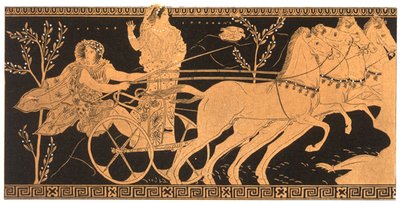Hippodamia
|
|
From hippos (horse) and damazo (to tame), "Tamer of horses."
Hippodamia 1
Peter_Paul_Rubens_100.jpg
In Greek mythology, Hippodamia was the bride of King Pirithous of the Lapiths. At their wedding, Hippodamia, the other female guests, and the young boys were almost abducted by the centaurs. Pirithous and his friend, Theseus, led the Lapiths to victor over the centaurs. With Pirithous, she mothered Polypoetes.
Hippodamia 2
In Greek mythology, Hippodamia was a daughter of King Oenomaus and mother of Agamemnon, Aegisthus, Pittheus and Menelaus, Alacathous by Pelops. Her name is borne by the asteroid 692 Hippodamia.
Pelops wanted to marry Hippodamia. Oenamaus had pursued thirteen suitors of Hippodamia and killed them all after beating them in a chariot race. He did this because he loved her himself or, alternatively, because a prophecy claimed he would be killed by her son. Pelops (or alternatively, Hippodamia herself) convinced Myrtilus (by promising him half of Oenomaus kingdom), Oenomaus' charioteer to remove the linchpins attaching the wheels to the chariot. Oenomaus died. Pelops then killed Myrtilus because he didn't want to share the credit for winning the chariot race, or because Myrtilus had attempted to rape Hippodamia. As Myrtilus died, he cursed Pelops. This was the source of the curse that haunted Pelops' descendants, including Atreus, Thyestes, Agamemnon, Aegisthus, Menelaus and Orestes.
Alternative: Hippodamea
Spoken-word myths - audio files
| Hippodamia myths as told by story tellers |
|---|
| 1. Marriage of Pelops and Hippodamia, read by Timothy Carter |
| Bibliography of reconstruction: Pindar, Olympian Ode, I (476 BCE); Sophocles, (1) Electra, 504 (430 - 415 BCE) & (2) Oenomaus, Fr. 433 (408 BCE); Euripides, Orestes, 1024-1062 (408 BCE); Apollodorus, Epitomes 2, 1-9 (140 BCE); Diodorus Siculus, Histories, 4.73 (1st c. BCE); Hyginus, Fables, 84: Oinomaus; Poetic Astronomy, ii (1st c. CE); Pausanias, Description of Greece, 5.1.3 - 7; 5.13.1; 6.21.9; 8.14.10 - 11 (ca. 160 - 176 CE); Philostratus the Elder Imagines, I.30: Pelops (170 - 245 CE); Philostratus the Younger, Imagines, 9: Pelops (ca. 200 - 245 CE); First Vatican Mythographer, 22: Myrtilus; Atreus et Thyestes; Second Vatican Mythographer, 146: Oenomaus |
| 2. Downfall of Pelops and Hippodamia (integral to the Laius and Chrysippus myth), read by Timothy Carter |
| Bibliography of reconstruction: Pindar, Olympian Ode, I (476 BCE); Apollodorus Library and Epitome 3.5.5 (140 BCE); Hyginus, Fables, 85. Chrysippus; 243. Women who Committed Suicide (1st c. CE); Pausanias, Description of Greece, 9.5.5-10, 6.20.7 (c. 160 - 176 CE); Athenaeus, The Deipnosophists, Book XIII, 602 (c. 200 CE); Clement of Alexandria, Exhortation to the Greeks, ii, 34, 3 - 5 (150 - 215 CE) |

